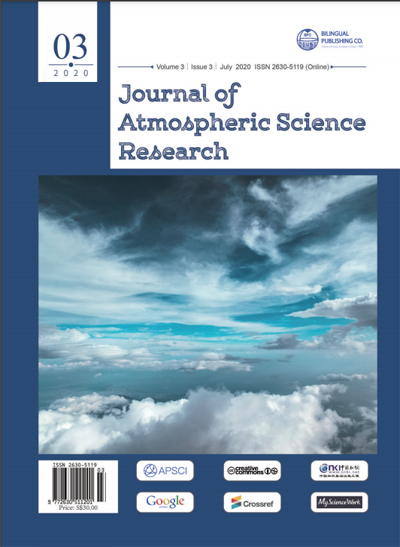-
877
-
400
-
358
-
355
-
339
Global Environmental Forecast and Roadmap Based on 420 kY of Paleoclimatology
DOI:
https://doi.org/10.30564/jasr.v3i3.2191Abstract
As the world’s population has tripled (3x) since 1950, with another 50% increase expected by 2100, global annual carbon dioxide emissions growth rate has quadrupled (4x) since 1950 and global energy demand has quintupled (5x), all in the same time period. This discontinuous combination can be called a “3-4-5 Triad” and the sudden acceleration in all three arenas is too stressful on the environment and the damaging effects will be felt globally for centuries to come unless drastic action is taken. More importantly, the energy demand at 5x is outstripping the other two. This clearly means that as the population explodes at 3x, the emerging middle class wants almost twice as much as their usual share as fossil-fueled generators spread around the globe and modern conveniences become more and more desirable. However, such energy demand at 5x is an artificial human need that is predicted by RMI.org to result in four to five billion new window-mounted air conditioners by 2050 that will add even more to the global warming caused by increasing atmospheric carbon. By an examination of paleoclimatology for the past 420,000 years, it is demonstrable that reducing the concentration of this single most prolific heat-trapping gas by geoengineering back to pre-industrial levels of less than 300 ppm can actually give humankind a collective control over the world’s rapidly rising average global temperature and once more, a temperate climate to live in.
Keywords:
Climate change; Thermal forcing; Temperature; Carbon dioxide; PETM; Carbon emissions; Carbon capture and storage; Climate Chart; PaleoclimatologyReferences
[1] Dennis, Brady, Chris Mooney. “We are in trouble”. Global carbon emissions reached a record high in 2018. Washington Post, 2018.
[2] Northern Arizona University. Major new paleoclimatology study shows global warming has upended 6,500 years of cooling. Phys.org, 2020. https://phys.org/news/2020-06-major-paleoclimatology-global-upended-years.html
[3] Muyskens, John. The unmitigated growth of carbon emissions. source: Global Carbon Project, Washington Post, 2018.
[4] Freedman, Andrew. Temperature in Antarctica soars to near 70 degrees, appearing to topple continental record set days earlier. Washington Post, February 14, 2019.
[5] Petit J.R., Jouzel J., Raynaud D., Barkov N.I., Barnola J.M., et al. Climate and Atmospheric History of the Past 420,000 years from the Vostok Ice Core, Antarctica. Nature, 1999, 399: 429-436.
[6] Lambert, Jonathan.Deadly heat and humidity are here. Science News, 2020. https://www.sciencenews.org
[7] Bowen, Mark. The Messenger. July 1, 2006, MIT Technology Review, NASA Goddard Institute of Space Studies, Technology Review, 2006: 40-41. https://s3.amazonaws.com/files.technologyreview.com/p/pub/legacy/articlefiles/climatechart.pdf
[8] Brown, Patrick, Ken Caldeira. Greater future global warming inferred from Earth’s recent energy budget. Nature, 2017, 552: 45-50.
[9] Projections of Climate Change: 2100 and Beyond. part 2, University of Washington. https://atmos.uw.edu/academics/classes/2011Q1/101/Climate_Change_2011_part2.pdf
[10] Temple, James. How green sand could capture billions of tons of carbon dioxide. MIT Technology Review, 2020. https://www.technologyreview.com/2020/06/22/1004218/how-green-sand-could-capture-billions-oftons-of-carbon-dioxide
[11] Valone, Thomas, Jacqueline Panting. Quantitative Carbon Dioxide, Temperature, and Sea Level Relation for the Future of Terrestrial Fossil-Fueled Technology, An Accurate Predictive Model Based on Vostok 420 kY Historical Record. IEEE International Symposium on Technology and Society (ISTAS) Proceedings, 15-16 November 2019, School of Engineering, Tufts University, Medford MA. https://www.slideshare.net/ThomasValonePhD/valone-ieee-istas2019ppt-ver4-with-extra-slide-withlinks-at-end
[12] Savage, Karen. Minnesota Sues Fossil Fuel Industry for Climate Fraud. The Climate Docket, 2020. https://www.climatedocket.com/2020/06/24/minnesota-climate-lawsuit-exxon-koch-api
[13] Holthaus, Eric. The Future Earth: A Radical Vision for What’s Possible in the Age of Warming, HarperOne, HarperCollins Publishers, 2020.
[14] Rathi, Akshat. Norway’s $2.6 Billion Green Bet Could Help the Whole Planet: A carbon capture project aims to make Norway the hub for other countries to bury their emissions. Bloomberg Green, 2020. https://www.bloomberg.com/news/articles/2020-06-30/norway-carbon-capture-plan-aimsto-let-countries-bury-emissions
[15] Keith, David W. A Process for Capturing CO2 from the Atmosphere. Joule, 2018, 2: 1573-1594. (open access). https://doi.org/10.1016/j.joule.2018.05.006
[16] Socolow, R. et al. Direct Air Capture of CO2 with Chemicals: A Technology Assessment for the APS Panel on Public Affairs. 2011. (open access). https://infoscience.epfl.ch/record/200555/files/dac2011.pdf
[17] Lackner, Klaus S. The urgency of the development of CO2 capture from ambient air. PNAS, 2012, 109(33):13156-13162. https://doi.org/10.1073/pnas.1108765109
[18] Sanz-Perez, Eloy S. et al. Direct Capture of CO2 from Ambient Air. Chemical Reviews, 2016, 116(19):11840-11876. https://pubs.acs.org/doi/10.1021/acs.chemrev.6b00173
[19] Martin D. et al. Carbon Dioxide Removal Options: A Literature Review Identifying Carbon Removal Potentials and Costs. University of Michigan Energy Institute, 2018. (Available at:) http://energy.umich.edu/research/publications/carbon-dioxide-removal-options-literature-review-identifying-carbon-removal
[20] Wilcox J. et al. Assessment of reasonable opportunities for direct air capture. Environ. Res. Lett. 2017,12: 065001. (open access) https://iopscience.iop.org/article/10.1088/1748-9326/aa6de5 Mazzotti M. et al. Direct air capture of CO2 with chemicals: optimization of a two-loop hydroxide carbonate system using a countercurrent air-liquid contactor. Climate Change. 2013, 118: 119-135. (open access) https://link.springer.com/article/10.1007/s10584-012-0679-y
[21] Stolaroff J.K. et al. Carbon dioxide capture from atmospheric air using sodium hydroxide spray. Environ. Sci. Technol. 2008, 42: 2728-2735. https://pubs.acs.org/doi/10.1021/es702607w
[22] Zeman F. Reducing the cost of Ca-based direct air capture of CO2. Environ. Sci. Technol. 2014, 48:11730-11735. https://pubs.acs.org/doi/10.1021/es502887y
[23] Burhenne L. et al. Characterization of reactive CaCO3 crystallization in a fluidized bed reactor as a central process of direct air capture. J. Environ. Chem. Eng. 2017, 5: 5968-5977. https://www.sciencedirect.com/science/article/abs/pii/S2213343717305481
[24] Holmes G. et al. An air-liquid contactor for largescale capture of CO2 from air. Philos. Trans. A Math. Phys. Eng. Sci. 2012, 370: 4380-4403. (open access) https://royalsocietypublishing.org/doi/10.1098/rsta.2012.0137
[25] Holmes G. et al. Outdoor prototype results for direct atmospheric capture of carbon dioxide. Energy Procedia. 2013: 6079-6095. https://doi.org/10.1016/j.egypro.2013.06.537
[26] Smith P. et al. Biophysical and economic limits to negative CO2 emissions. Nat. Clim. Change. 2016; 6:42-50.
[27] https://www.nature.com/articles/nclimate2870. Accessed by: https://kopernio.com/viewer?doi=10.1038/nclimate2870&route=1
Downloads
How to Cite
Issue
Article Type
License
Copyright © 2020 Author(s)

This is an open access article under the Creative Commons Attribution-NonCommercial 4.0 International (CC BY-NC 4.0) License.




 Thomas F. Valone
Thomas F. Valone





